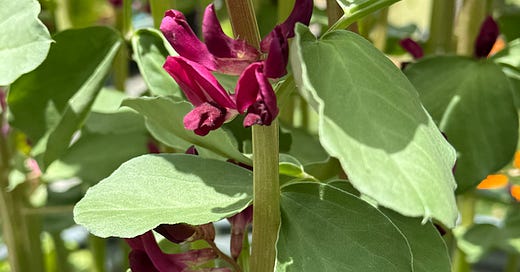Growing Fava Beans
Favas, also known as broad beans, are an easy-to-grow legume with a nutty flavor, beautiful blue-green foliage, and fragrant flowers beloved by pollinators. The plants withstand freezing and grow in cool weather making them a choice (& delicious) crop to sneak into the shoulders on either side of the traditional summer growing season. In regions with mild winters and hot summers, sow fava seed in fall for an earlier harvest before the heat arrives and diminishes the crop.
Like all legumes, fava beans fix nitrogen in nodules along their roots, so the garden is actually left in better condition after harvest. Mature fresh fava beans are about the size of a lima bean only rather than the starchy, sometimes mealy texture of limas, fresh favas are tender and mild. (Apologies, my childhood distaste for limas is showing)



Growing
Fava beans thrive in well-drained, fertile soil and full sun. In late winter or very early spring, prepare wide rows 12 to 18 inches apart; plant each seed 1-1/2 to 2 inches deep every 4 to 5 inches. Hardy varieties may be sown in autumn and overwintered for an earlier harvest. You can also sow a second crop in early May to ensure a steady harvest throughout summer, although production will suffer when temperatures rise above 80°F.
Water well during dry spells to keep plants actively growing. Sturdy nonbranching plants benefit from staking in exposed conditions. When plants are in full flower and pods are beginning to form, pinch out the top 4 inches of growth to promote ripening; blanch or quickly sauté these tender growing tips for a bonus crop. Removing top growth also discourages black aphids, which may attack plants in late spring.
Harvesting
Beginning in June (from plants sown in late winter), bright green, upright pods form where leaves meet the stem, ripening from the bottom of the plant up. Harvest beans when they have plumped to fill the pods, snipping with scissors or pruners to avoid damaging the plants. Fava beans make a vibrant tasty pesto whirled together with lemon zest and olive oil or prepared in any fresh shell bean recipe.
Varieties
While flavor varies little, hardier varieties are more tolerant of our wet winters. Broad Windsor is a dependable 4-foot-tall garden standard and very hardy; Frog Island Nation has tasty large purple seeds; Crimson Flowered is a compact variety that produces copious quantities of smaller pods and beautiful, fragrant, crimson flowers on sturdy 3-foot-tall stems.
The above slightly edited excerpt is from my upcoming book(s) “Grow Great Vegetables Washington/Oregon/British Columbia” coming in February 2026 from Timber Press.



